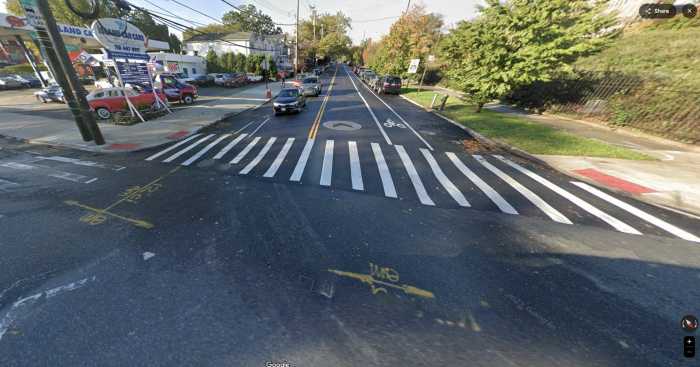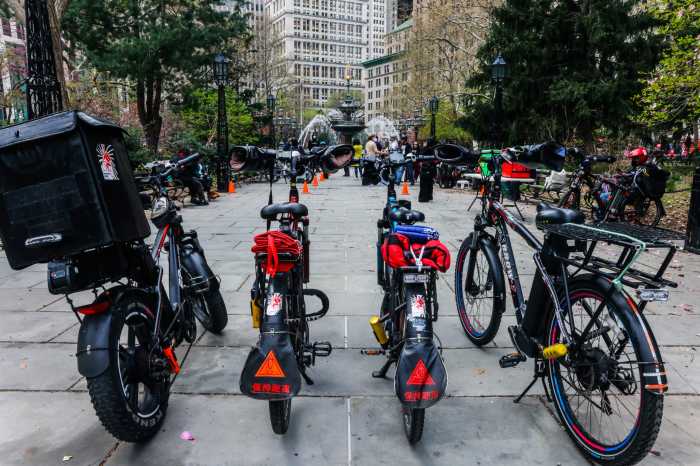The city has set its sights on fixing its “Times Square in the sky.”
The Brooklyn Bridge, dubbed as such by a deputy city Department of Transportation commissioner, has a notoriously crowded bicycle and pedestrian path, and the city announced Monday that it will launch a study into whether the path could be widened.
“The Brooklyn Bridge has had a bunch of evolutions in the course of its 133-year-old life,” said Polly Trottenberg, commissioner of the city’s DOT, at a news conference near the Manhattan approach. “It’s time to take a fresh look at what the next iteration is going to look like in terms of accommodating the incredible growth and activity that we’ve seen on the bridge.”
Each day, some 10,000 pedestrians and 3,500 cyclists cross under the bridge’s famous limestone and granite towers — a steep increase compared to recent years. Weekend walkers along the span grew by 275%, when comparing volumes from May 2015 to May 2008. During the same time period, 93% more bikers used the bridge in the evening rush hour, according to the city DOT.
The city has hired the consulting firm AECOM to conduct a seven-month, $370,000 engineering study to determine how much weight the bridge can bear and if the existing wooden plank promenade could be extended on top of the existing roadway.
During a trip over the bridge, the width of the bicycle and pedestrian paths varies greatly at different points. The promenade generally ranges from 17 feet at its widest, to 10 feet at its narrowest, “which is pretty narrow, given the incredible volume of activity that we’re seeing there,” Trottenberg said.
“So if we could find a way to build out the paths further onto those girders [above vehicles],” she added, “we could have a greatly expanded pedestrian and cycling space.”
That expansion could theoretically grant enough room to physically separate cyclists and pedestrians, which are constantly at odds over their two slivers of bridge real estate. As the span’s vantage points remind visitors of Manhattan and Brooklyn’s beauty, the bridge’s cyclists remind visitors that they’re standing in a bike lane.
“The biggest problem is all the tourists standing in the bike lanes taking selfies,” said bike messenger Joel Davis, 35, of Harlem, as he prepared to cross the bridge from Manhattan. “Giving us all more space would be great.”
Further up Davis’ approach, Florida painter Ralph Papa staked out a slice of the promenade, where he stood in front of his easel, painting the city skyline.
“This is the best view in all of New York City,” said Papa, of Palm Beach. “And you have the most interesting people passing you by from all corners of the world.”
But Papa, who visits the bridge to paint about twice a year, said he’s aware of the pedestrian-cyclist conflict.
“An expansion is an excellent idea. You have kids here and bikes here,” he said. “It can be dangerous.”
Despite observations, the city says the bridge is relatively safe. According to police data the DOT provided, three pedestrians were injured on the bridge in 2015.
Trottenberg cautioned that the study is nothing more than that at this point. “The biggest challenge is a fundamental one, which is, ‘Is the engineering feasible?’” she said. “Can we find a way to accommodate the weight and come up with a design that would work on the bridge and work on both approaches?”
Her agency would also have to work with the NYPD and the Landmark Preservation Commission should they move foward.
Project cost is also unclear. Trottenberg warned that, because of the bridge’s old age, its capital construction tends to be pricey.
But for advocates, the time is now. Sensing the enthusiasm, Trottenberg added that if a promenade expansion isn’t possible, the department wouldn’t rule out designating space on the roadbed to cyclists.
“Bike commuting is only on the rise,” said Caroline Samponaro, deputy director at Transportation Alternatives. “Many new neighborhoods in Brooklyn are about to get bike share; all of this is going to increase the number of people trying to make that bike commute over the bridge. It’s great that the DOT is getting out of ahead of this and expressing the commitment to addressing that need.”





































